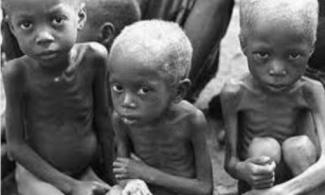
The Global Hunger Index (GHI) was jointly published by the German-based Welthungerhilfe and Dublin-based Concern Worldwide on Friday.
11.4 percent of children born in Nigeria have reportedly died before reaching five years due to acute hunger, according to the 2022 Global Hunger Index.
The Global Hunger Index (GHI) was jointly published by the German-based Welthungerhilfe and Dublin-based Concern Worldwide on Friday.
The GHI is a tool for measuring and tracking hunger on a global, regional, and national scale. Its scores are based on the values of four component indicators: malnutrition, stunting, wasting, and death in children.
Nigeria was ranked 103 out of 121 countries in the 2022 Global Hunger Index, a position that signifies the nation “has a level of hunger that is serious”.
The survey, which ranks countries by "severity," gave Nigeria a score of 27.3, indicating a "serious" degree of hunger.
The measure categorises hunger into five levels: low, moderate, serious, alarming, and extremely alarming.
Nigeria's ranking on the scale has remained unchanged for the second year in a row. Nigeria, Africa's most populous country, was placed 103rd out of 116th in 2021, and 98th out of 107th in 2020.
According to the 2022 study, 12.7% of Nigeria's population is malnourished. It also shows that 6.5 percent of under-five children in the country are wasted, and 31.5 percent are stunted.
It also shows that 11.4 percent of Nigerian children die before reaching the age of five.
Undernourishment is defined as the proportion of the population that does not consume enough calories, whereas child stunting is defined as the proportion of children under the age of five who are short for their age, indicating chronic malnutrition.
Child wasting refers to the proportion of children under the age of five who are underweight for their height, indicating acute malnutrition; child mortality, on the other hand, refers to the proportion of children who die before reaching the age of five, reflecting a fatal combination of inadequate nutrition and unhealthy environments.
Based on the values of the four indicators, a GHI score is calculated on a 100-point scale reflecting the severity of hunger, where 0 is the best possible score (no hunger) and 100 is the worst. Each country’s GHI score is classified by severity, from low to extremely alarming.
According to the report, 17 countries including China, Hungary, Montenegro, Uzbekistan, Russia and Saudi Arabia shared the top rank with a GHI score of less than 5.
No country has been placed in the extremely alarming category this year.
According to the report, some 828 million people were affected by hunger globally in 2021, an increase of about 46 million people since 2020 and 150 million people since the outbreak of the COVID-19 pandemic.
The index indicates that the highest levels of hunger were in “Africa South of the Sahara” and South Asia – with progress against hunger in these regions having stagnated in recent years.
“The situation is likely to worsen in the face of the current barrage of overlapping global crises – conflict, climate change, and the economic fallout of the COVID-19 pandemic—all of which are powerful drivers of hunger,” the report said.
“The war in Ukraine has further increased global food, fuel, and fertilizer prices and has the potential to contribute to food shortages in 2023 and beyond.”